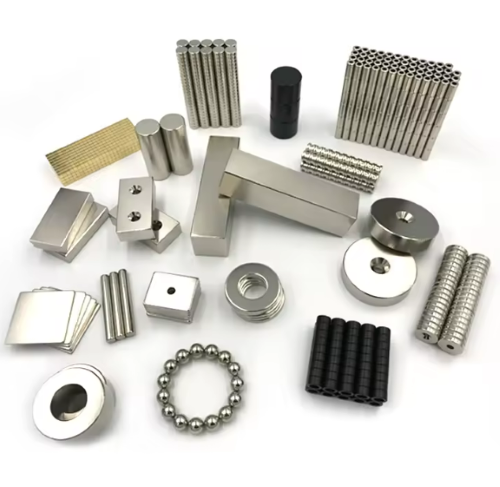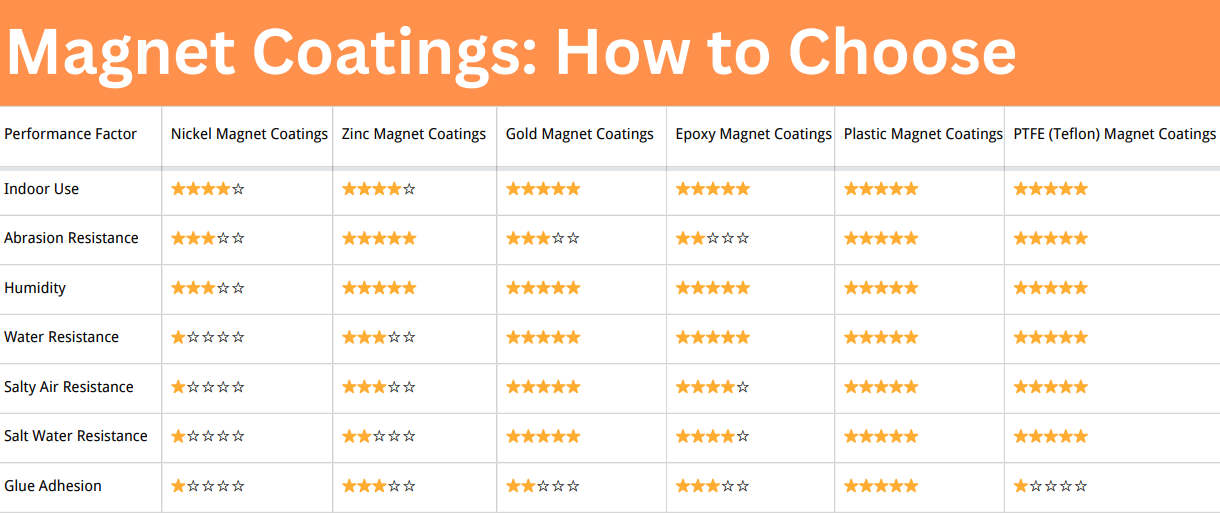Which Magnet Coating Is Best for Neodymium Magnets?
Introduction
Neodymium magnets come with exceptional strength, and they are used in a wide range of applications, from industrial machinery to household gadgets. However, these powerful magnets are prone to corrosion and physical damage. This article will discuss the importance of magnet coatings, the main types of coatings available, and the best coatings for neodymium magnets.

Why Are Magnets Coated?
1. Protection from Corrosion
Neodymium magnets are highly susceptible to corrosion, especially in environments with high humidity or exposure to chemicals. Corrosion can weaken the magnet and reduce its magnetic field, leading to a significant drop in performance. Coating the magnets provides a barrier that protects them from rust and other forms of corrosion.
2. Enhanced Durability
Magnet coatings improve the physical durability of neodymium magnets. They protect against chipping, cracking, and other forms of physical damage that can occur during handling, installation, or operation. This is particularly important in industrial and mechanical applications where magnets are subjected to harsh conditions.
3. Improved Aesthetic and Functional Properties
In addition to protection, coatings can enhance the aesthetic appeal of magnets, making them suitable for applications where appearance matters, such as in consumer electronics and decorative items. Coatings can also provide additional functional benefits, such as electrical conductivity or a non-slip surface.
Related reading: Coatings & Adhesives of Neodymium Magnets
Main Types of Neodymium Magnet Coatings
1. Nickel (Ni) Coating
Nickel coating is one of the most popular choices for neodymium magnets. It typically involves a layer of nickel-copper-nickel (Ni-Cu-Ni) plating. This multilayer approach enhances the magnet's resistance to corrosion and wear.
Nickel coating offers excellent corrosion resistance, a smooth, shiny finish, and a hard, durable surface. Nickel coated magnets are suitable for a wide range of applications, including industrial, medical, and consumer electronics.
2. Zinc (Zn) Coating
Zinc coating provides a protective layer that prevents oxidation and corrosion. It is often chosen for its cost-effectiveness and functional properties.
Such coating comes with good corrosion resistance, cost-effectiveness, and a dull, matte finish. Zinc coated magnets are ideal for outdoor and marine applications.
3. Epoxy Coating
Epoxy coatings are made of polymer resin and offer robust protection against moisture and chemicals. They can be applied in various colors, adding to their versatility.
The properties and benefits of epoxy coating include excellent moisture and chemical resistance, good abrasion resistance, and availability in various colors. Epoxy coated magnets are suitable for high-humidity environments and applications requiring impact resistance.
4. Gold (Au) Coating
Gold coating provides a thin layer of gold over the magnet, offering exceptional corrosion resistance and biocompatibility.
Gold coated magnets come with superior corrosion resistance, biocompatibility, and an attractive, shiny appearance. Gold coated magnets are used in medical devices, jewelry, and high-corrosion environments.
5. Silver (Ag) Coating
Silver coating offers both protective and conductive properties, making it suitable for specific applications requiring electrical conductivity.
The benefits include excellent electrical conductivity, good corrosion resistance, and an attractive appearance. Silver coated magnets are suitable for electronic applications and decorative items.
6. Rubber Coating
Rubber coatings add a flexible, non-slip layer to the magnet, providing impact protection and surface safety.
With impact resistance, water resistance, and a non-slip grip, rubber coated magnets are ideal for automotive, industrial, and household applications.
7. PTFE (Teflon) Coating
PTFE, commonly known as Teflon, provides a slick, non-stick surface with high chemical resistance.
PTFE coated neodymium magnets offer high chemical resistance, a low friction surface, and non-reactive properties. PTFE coated magnets are used in chemical industries and high-temperature environments.
8. Parylene Coating
Parylene is a conformal coating applied in a vapor deposition process, providing a uniform, pinhole-free layer.
The properties and benefits of parylene coating include an excellent chemical and moisture barrier, a uniform and pinhole-free coating, and high dielectric strength. Parylene coated magnets are used in medical devices and electronics.
What Are the Best Coatings?
Choosing the best coating for neodymium magnets depends on the specific application and environmental conditions. Here are some guidelines to help you select the most suitable coating:
- For General Use and Industrial Applications: Nickel (Ni) coating is often the best choice due to its excellent corrosion resistance, durability, and cost-effectiveness. It provides a hard, smooth surface that withstands wear and tear.
- For High-Humidity and Marine Environments: Epoxy and zinc coatings are ideal for environments with high humidity or exposure to water. Epoxy offers superior moisture resistance and is available in various colors, while zinc provides good corrosion resistance and is cost-effective.
- For Medical and Biocompatible Applications: Gold coating is the best option for applications requiring biocompatibility and high corrosion resistance.
- For Electrical and Electronic Applications: Silver coating is preferred for its excellent electrical conductivity and good corrosion resistance.
- For High-Impact and Outdoor Applications: Rubber coating provides impact resistance, water resistance, and a non-slip grip. It protects both the magnet and the contact surface from damage.
- For Chemical and High-Temperature Environments: PTFE (Teflon) coating is recommended for chemical industries and high-temperature applications. PTFE coated neodymium magnets offer high chemical resistance and a low-friction, non-reactive surface.
- For High-Performance Barrier Protection: Parylene coating is used in applications requiring a high-performance barrier against chemicals and moisture. Its uniform, pinhole-free coating makes it ideal for medical devices and sensitive electronic components.
Conclusion
Coating neodymium magnets is essential to enhance their performance, durability, and suitability for various applications. Whether it's for industrial use, high-humidity environments, medical devices, or high-temperature applications, selecting the right coating ensures that your neodymium magnets will perform optimally and last longer. For more information, please check Stanford Magnets.














